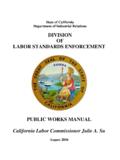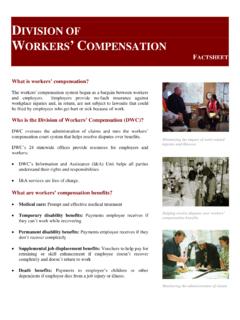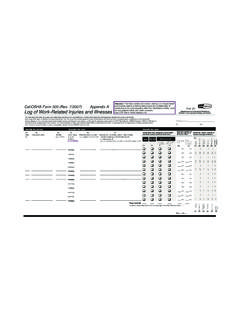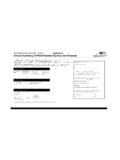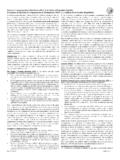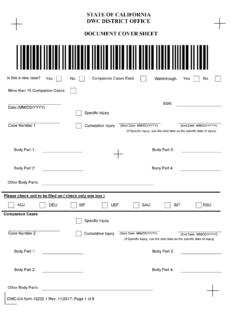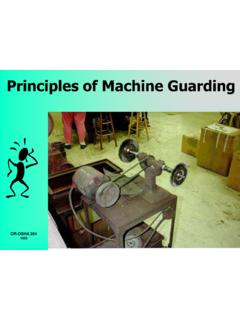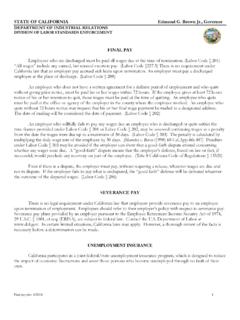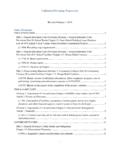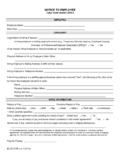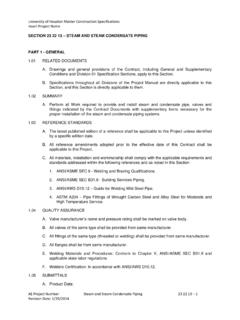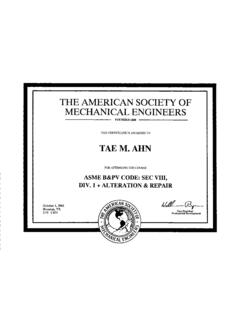Transcription of Pressure Relief Device Inspection
1 Pressure Relief Device Inspection Review of NBIC Part 2, par. Prepared by: J. F. Ball, P. E. Updated November 2016 1 Purpose of Pressure Relief Devices Last line of defense against overpressure condition Overpressure could lead to failure of the boiler or Pressure vessel (PRI) Protection for both persons and property PRDs are not designed as Pressure control devices! 2 Keys to In-service Inspection Safety considerations Pressure Relief Device and PRI data Device condition Installation condition Testing and Operational Inspection 3 Safety Considerations High Pressure discharge may have considerable energy released High temperatures may be involved (steam) High levels of noise encountered during testing 4 PRI Data First look at application and PRI nameplate Determine MAWP and design temperature Determine steaming capacity or heating surface for boilers What is the service fluid?
2 5 Device Data Correct Code Stamp for application Power and heating boilers Low Pressure steam heating boilers, hot water heating boilers, hot water heaters Unfired Pressure vessel service 6 asme Certification Mark with Designator New asme Certification Mark Replaced previous Code stamps after 2013 Designator gives service V, HV, UV, or UD for Pressure Relief devices X 7 Device Data Set Pressure Inspect Pressure Relief Device nameplate data Set Pressure for single Device cannot exceed MAWP Set Pressure of high set Device where multiple devices are installed may exceed MAWP +3% for Section I boilers +5% for heating boilers +5% for Pressure vessels +10% for Pressure vessel fire case Section I valves must have spread less than 10% 8 Device Data Repair plate could change data on original plate 9 NB Cert #VR SymbolMODEL:SET:CDTP:CAP.
3 :DATE:RECORD No.: Valve may also have test only nameplate Will show date of test Responsible party Gives traceability if valve reset Device Data 10 Missing Nameplates 2013 asme Code, Section I, Appendix III included RITERI! FOR REAPPLICATION OF A CERTIFICATION M!RK Not practically written for Pressure Relief valves NBIC Part 3, par. includes provisions for duplicate nameplates (must be done along with VR repair) Includes instead of ode stamp 11 Device Data - Capacity For boilers, combined valve capacity must exceed maximum designed steaming capacity NBIC Part 1, Table gives calculation method when heating area is used (need to know boiler fuel) 12 Compare valve capacity in BTU/Hr to burner input for heating boilers Has burner or fuel been changed?
4 Device Data -capacity 13 Device Data Valve Seals Valve seals must have correct identification Valve seal identification must match other information on the valve OEM seal Repair company seal should match repair nameplate Seal may match test only nameplate 14 Device Condition Seals intact Bolting tight and no bolts missing Deposits or material buildup Damaged or missing parts 15 Device Condition Small valves may be permanently sealed (what s wrong here?) 16 Device Condition 17 Valve should not be leaking Drain hole not clogged or plugged Bellows valve bonnet vent not plugged No leakage throughbonnet ventDevice Condition 18 No test gag!
5 Device Condition 19 Installation Condition No reduced inlet or outlet pipe sizes Drain piping open Piping should not be binding on valve Piping should not besupported by valve Discharge hazards topersonnel20 Typical asme Section I Safety Valve Installation 21 Installation Condition 22 What s wrong here? Installation Condition 23 Installation Condition Rupture disk installation under PRV No Pressure on gage 24 Installation Condition Isolation valves Not permitted for boilers or hot water heaters May be permitted in some Pressure vessel applications asme Code Appendix M requirements Jurisdiction must approve 25 Installation Condition Change-over valves 26 Testing and Operational Inspection Does the valve actually work?
6 Lift lever test !t least it s not stuck Test at 75% of set Pressure for boiler or Pressure vessel valves Section IV valves can be checked without Pressure Section VIII: Test lever required for valves for steam, air, and hot water over 140 deg. F. 27 Testing and Operational Inspection Rope can be tied to lever for personnel safety Assure rope does not affect valve !llow valve to snap shut 28 29 30 Set Pressure test Set Pressure within Code tolerance Valve should not be leaking Full Pressure test on unit (not accumulation test) Remove valve and check on test stand Testing and Operational Inspection 31 Lift assist devices sometimes used to check valve on-line without a full pop test Testing and Operational Inspection 32 Testing and Operational Inspection Corrective Action Remove system from service if valve is stuck shut!
7 (+16%) Out of set Pressure tolerance (NBIC Part 2, par. g)) Minor adjustment = 2x set tolerance Must be done by qualified organization Major adjustment indicates a repair is needed 33 What is a Qualified Organization? N I defines a qualified organization as an organization accredited by the National oard Could be National Board VR or T/O certified organization Part 3, Supplement gives outline of requirements for potential Jurisdictional acceptance 34 Recommended Test Frequencies Jurisdictional Rules NBIC recommendations Boilers less than 400 psi manual test every 6 months, annual Pressure test Boilers greater than 400 psi Pressure test every three years High temp.
8 Hot water boilers annual Pressure test Low Pressure boilers (15 psi) manual test quarterly, annual Pressure test before heating season 35 Hot water heating boilers manual test quarterly, annual Pressure test before heating season Hot water heating boilers manual test quarterly, annual Pressure test before heating season Water heaters manual test every 2 months (replace if defective) Recommended Test Frequencies 36 Recommended Test Frequencies Pressure Vessel and Piping Applications To determine Inspection frequency, the vessel contents, system operation, and previous Inspection history must be reviewed Steam annually Air, clean dry gasses every 3 years PRV with rupture disk 5 years Propane, refrigerant 5 years All others Per Inspection History 37 Sample Inspection Checklist 38 39 Final Exam (outlet piping) 40 Final Exam What s wrong with this installation?
9 Final Exam 41 Conclusions Pressure Relief devices are important to safe system operation Inspections must be done to assure devices are installed and functioning properly THANK YOU! 42
